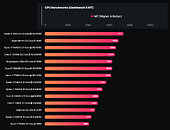T0@st
News Editor
- Joined
- Mar 7, 2023
- Messages
- 2,768 (3.68/day)
- Location
- South East, UK
| System Name | The TPU Typewriter |
|---|---|
| Processor | AMD Ryzen 5 5600 (non-X) |
| Motherboard | GIGABYTE B550M DS3H Micro ATX |
| Cooling | DeepCool AS500 |
| Memory | Kingston Fury Renegade RGB 32 GB (2 x 16 GB) DDR4-3600 CL16 |
| Video Card(s) | PowerColor Radeon RX 7800 XT 16 GB Hellhound OC |
| Storage | Samsung 980 Pro 1 TB M.2-2280 PCIe 4.0 X4 NVME SSD |
| Display(s) | Lenovo Legion Y27q-20 27" QHD IPS monitor |
| Case | GameMax Spark M-ATX (re-badged Jonsbo D30) |
| Audio Device(s) | FiiO K7 Desktop DAC/Amp + Philips Fidelio X3 headphones, or ARTTI T10 Planar IEMs |
| Power Supply | ADATA XPG CORE Reactor 650 W 80+ Gold ATX |
| Mouse | Roccat Kone Pro Air |
| Keyboard | Cooler Master MasterKeys Pro L |
| Software | Windows 10 64-bit Home Edition |
Last October, Qualcomm introduced Snapdragon X Elite as its most powerful computing processor for PC, but the ARM-based mobile solution is still months away from launch—officially mid-2024. Company leadership has indicated that their custom Oryon CPU—for the "thin-and-light notebook market"—could be hitting retail at the same time as Microsoft's heavily rumored "Windows 12" inauguration. Several PC news outlets have picked up on a mysterious Qualcomm "ZH-WXX" platform appearing on Geekbench Browser—the February 22 entrant seems to be a prototype notebook that sports a "Snapdragon X Elite - X1E80100 - Qualcomm Oryon CPU," and 32 GB of LPDDR5x memory.
There are no next generation operating system revelations here—the system was running a 64-bit install of Windows 11 Insider Preview. Overall Geekbench 6.2.2 tallies are 2574 (single-core), and 12562 (multi-core)—positioning the 12-core Snapdragon X Elite engineering sample just above AMD's Ryzen 9 7940HS top-end mobility-focused "Phoenix" APU in terms of performance. Geekbench Browser's "CPU Information" section identifies the alleged high-end Snapdragon X Elite processor as a "ARMv8 (64-bit) Family 8 Model 1 Revision 201" part. Average clock speeds were listed as 4.01 GHz (base frequency). Cluster 1 seems to contain eight Nuvia-designed Oryon processor cores, while Cluster 2 receives the remaining four units.




According to Wccftech: "the top Qualcomm Snapdragon X Elite CPU will come in 12-core configurations with a total of 8 high-performance and 4 efficiency-optimized cores based on TSMC's 4 nm process node. The clock speeds for the chip will be set at 4.3 GHz across 1-2 cores and 3.8 GHz for all-core while adopting a large 42 MB cache." The publication highlighted an October 2023 set of results—they reckon that "X1E80100" is closer to being the final article, when compared to the older/previously benched candidate. A leaked 3DMark Wildlife Extreme benchmark—from the same time period—indicated that the Snapdragon X Elite's Adreno integrated graphics solution was already capable of besting Team Red's Radeon 780M iGPU.


Wccftech has compiled the latest results into comparison charts—look just above. Accompanying analysis stated: "Qualcomm Snapdragon X Elite 12-Core CPU was faster than both AMD & Intel chips in single-core performance despite the latter two running at much higher clock speeds of 5.2 & 5.0 GHz respectively. The Snapdragon chip can only maintain a maximum clock speed of 4 GHz across 1 or 2 cores. All benchmarks were conducted on the same Windows platform and didn't use Linux platforms although you can find Linux tests shared by Benchleaks here. When comparing the multi-core performance, the Intel Core i7-12700K Desktop CPU ends up 4% faster while the AMD Ryzen 9 7845HX CPU ends up 5% faster. This is a very impressive multi-thread performance from the Oryon CPU architecture at just 28 W and the 80 W chip can easily outperform the two competitors. Based on the performance results, we can seethat the chip sits in a good position against the other competing chips from AMD and Intel. The Intel Core Ultra 9 185H takes a lead in the multi-threaded benchmarks while the Ryzen 9 7940HS which is essentially the same spec as the 8840HS is slightly behind but that's to be expected since it's an 8-core chip versus the 12-core Snapdragon & 16 core Intel offering."
View at TechPowerUp Main Site | Source
There are no next generation operating system revelations here—the system was running a 64-bit install of Windows 11 Insider Preview. Overall Geekbench 6.2.2 tallies are 2574 (single-core), and 12562 (multi-core)—positioning the 12-core Snapdragon X Elite engineering sample just above AMD's Ryzen 9 7940HS top-end mobility-focused "Phoenix" APU in terms of performance. Geekbench Browser's "CPU Information" section identifies the alleged high-end Snapdragon X Elite processor as a "ARMv8 (64-bit) Family 8 Model 1 Revision 201" part. Average clock speeds were listed as 4.01 GHz (base frequency). Cluster 1 seems to contain eight Nuvia-designed Oryon processor cores, while Cluster 2 receives the remaining four units.




According to Wccftech: "the top Qualcomm Snapdragon X Elite CPU will come in 12-core configurations with a total of 8 high-performance and 4 efficiency-optimized cores based on TSMC's 4 nm process node. The clock speeds for the chip will be set at 4.3 GHz across 1-2 cores and 3.8 GHz for all-core while adopting a large 42 MB cache." The publication highlighted an October 2023 set of results—they reckon that "X1E80100" is closer to being the final article, when compared to the older/previously benched candidate. A leaked 3DMark Wildlife Extreme benchmark—from the same time period—indicated that the Snapdragon X Elite's Adreno integrated graphics solution was already capable of besting Team Red's Radeon 780M iGPU.


Wccftech has compiled the latest results into comparison charts—look just above. Accompanying analysis stated: "Qualcomm Snapdragon X Elite 12-Core CPU was faster than both AMD & Intel chips in single-core performance despite the latter two running at much higher clock speeds of 5.2 & 5.0 GHz respectively. The Snapdragon chip can only maintain a maximum clock speed of 4 GHz across 1 or 2 cores. All benchmarks were conducted on the same Windows platform and didn't use Linux platforms although you can find Linux tests shared by Benchleaks here. When comparing the multi-core performance, the Intel Core i7-12700K Desktop CPU ends up 4% faster while the AMD Ryzen 9 7845HX CPU ends up 5% faster. This is a very impressive multi-thread performance from the Oryon CPU architecture at just 28 W and the 80 W chip can easily outperform the two competitors. Based on the performance results, we can seethat the chip sits in a good position against the other competing chips from AMD and Intel. The Intel Core Ultra 9 185H takes a lead in the multi-threaded benchmarks while the Ryzen 9 7940HS which is essentially the same spec as the 8840HS is slightly behind but that's to be expected since it's an 8-core chip versus the 12-core Snapdragon & 16 core Intel offering."
View at TechPowerUp Main Site | Source



